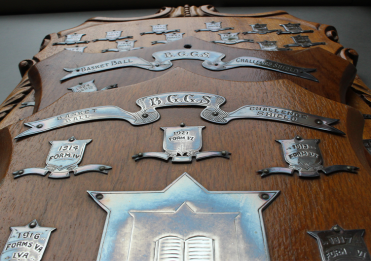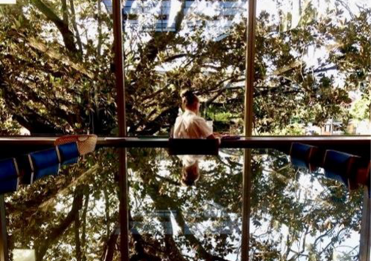Residing in the ever-increasing, much cherished Girls Grammar uniform archive is a pair of royal blue knickerbockers—those rather old-fashioned or strange-looking three-quarter-length pants. These pants, donated by Geordan Shannon (2002), give us an insight into the philosophy and development of the Queensland Girls Secondary Sports Association (QGSSSA), a group of women (at that time) that was always on the lookout to enhance sporting opportunities for girls. Geordie’s knickerbockers provide the opportunity to look back at the emergence of another Girls Grammar sport in the 1960s: Softball.

2002 Geordan Shannon (2002), BGGS Captain and Australian U19 player
The first Grammar softballers did not have specialist uniforms. Imagine sliding into third base, on rough grass and dirt on a humid Brisbane February morning, wearing a short gym tunic and bloomers! All the more recent softballers reading this article would be cringing, displaying horror and shock, or just shaking their heads. Some older Grammar girls might be saying, ‘Well that’s the way it was then, so suck it up, princess!’
Softball was introduced to Australia during World War II in 1942 by American Serviceman, William Duvernet, in Victoria. The game was introduced to Queensland by American, Mack Gilley, in 1946 and soon the Queensland Softball and Baseball Association was formed, with Mack Gilley as president.
The popularity of the game grew within Australia where clubs were formed, softball knickerbockers were donned, and a healthy interstate competition was run annually.

C19th century knickerbockers

Geordan Shannon’s (2002) 21st century knickerbockers
This traditional uniform of knickerbockers began in the United States, where the term was first used in a sporting context in 1845 with the newly minted baseball team the New York Knickerbockers. Their uniform utilised the Dutch-designed pants of a gathered waist and pleated or buckled gathering at the knees. This attire was adopted by golfers and 19th century women cyclists, as well as softballers, for its ease of movement and protection from the elements.
Softball gained international popularity and Australia hosted the first World Series in Melbourne in 1965, at which we won, competing against USA, Japan, New Zealand, and Papua New Guinea. It is therefore not surprising that the sport, with its growing credibility and popularity, came to the attention of the sports mistresses of QGSSSA.
When Softball was introduced as a fledgling QGSSSA sport in 1965, the wearing of specialised clothing was deemed unnecessary. So, teams competed in their normal sports uniforms.

1965, inaugural QGSSSA Softball team premiers— Katherine Alono (Smith, 1967), Paula Airton (Purvis, 1965), Eleanor Martin (Roediger, 1967), Sally Beeston (Tilbury, 1966), Suzanne O'Brien (Stevens, 1965), Margaret Gilchrist (1966), Margaret Laas (Haken, 1966), Lynda Kleimeyer (1970), Catherine Marks (Roberts, 1965), Lynne Reid (1965), Deborah Verner (1968).
Girls Grammar entered a team in the inaugural QGSSSA competition, winning the premiership. The squad was made up of nine players and two reserves. The captain of the team was second base, Jane Roberts (1965), and the team boasted a state representative softball player and pitcher, Lynda Kleimeyer (1970). Her catcher, Paula Airton (Purvis, 1965), reminisced, ‘I have no claim to being any great shakes as a catcher—Lindi (sic) made me look way better than I was. She was amazing and could pitch into my glove wherever I put it. Her first two pitches would be fast and straight over the plate, so unhittable, and the third would be over to the side away from the batter, so a ball, and straight into my glove. Strike three!’
Both Lynda Mackenzie (Kleimeyer, 1970) and Eleanor Martin (Roediger, 1967) remembered the camaraderie of the team. Lynda recalled, ‘As softball was a new sport to (Girls) Grammar we all tried our best to make it work well. Wonderful memories with good people’ (Email 21.1.24). Eleanor said, ‘I can remember … the bond as a team. We played well together and were a solid team with good support’ (Email 23.1.24).

1967, Lynda Kleimeyer (1970) at Downey Park, source unknown
As Brisbane softball clubs grew and more girls were introduced to the sport at primary school, QGSSSA schools were blessed with students who understood this complex, skilful game, its highly competitive nature and physicality. Therefore, more girls were willing and possessed the skills to slide into home plate to score the winning run or ‘steal’ second base by executing a hook slide.
As the captain of Softball in 1971, I was supported by my mother, Mrs Joy Harvey, and Physical Education teacher, Mrs Jan Salzman (1960), in approaching the Headmistress, Miss Nancy Shaw, with a new Girls Grammar Softball uniform (created by Mrs Joy Harvey) incorporating royal blue caesarella knickerbockers with a sleeveless V-neck top and white undershirt. I can remember standing nervously in Miss Shaw’s office modelling the new uniform, desperately hoping she would agree to the concept. The rest is history, as they say, with the new design being a first of its kind in the QGSSSA competition. Knickerbockers soon became de rigueur with the other QGSSSA schools, as it gave added protection and confidence to the players, enhanced skills, and offered a professional appearance to the sport.

1971 uniform design submitted to Miss Nancy Shaw for approval

1971 A Grade Softball team in new uniform with knickerbockers. Back row—Glenda Lemon (Stewart, 1972), Pauline Harvey-Short (Harvey, 1971) (captain), Jane Allen (1972), Anna Newman (Beveridge, 1972). Front row—Heather Bell (1972), Pamela Purvis (1972), Delphine Weatherall (1972), Julianne Enright (1973).
This uniform prevailed throughout the 1970s and 80s when the top was adopted by Girls Grammar athletes for both Athletics and Cross Country. Several improvements were added across the 80s with gaiters added over short socks, eventually transitioning into full-length socks giving the illusion of gaiters and eliminating another item of clothing. A new Physical Education top with short sleeves and a collar was introduced into the sports uniform and adopted by the softballers in 1984. Once again, a comfortable alternative and one less piece of clothing for the athletes to lose!

2002, Geordan Shannon (2002) receiving the Open pennant
As fabrics improved, the caesarella pants material was replaced with a thicker, more durable cloth for the knickerbockers. When Geordie Shannon was asked to reflect on her first impressions as a Year 8 Grammar softballer, she said ‘I remember being eager to connect with other students across grades and Houses, and to be able to operate at a skill level that was challenging yet supported. I also really liked the uniform!’ (Email 31.01.24).
In 2004, shorts made of a royal-blue polyester pique fabric with a knitted white keyline stripe stitched down each side were introduced.
Kate Martin (2004), Softball captain in 2004, was proud of the new uniform and being part of the QGSSSA competition. Kate commented ‘Some of my fondest memories of being a Grammar girl are those from QGSSSA Softball both as a player, a captain and as a coach. The softball community amongst the QG schools and beyond was unmatched and some of my closest friends to this day were developed on the softball field’ (Email 30.01.24).

2004, Jacklyn Lock (Vosloo, 2004), Kate Martin (2004) (captain), Anna Hogan (2004), Laura Kidd (2004), Josie Laddin (Walsh, 2004)
Initially, only the Open and Senior teams wore shorts. As with the 1971 request, Girls Grammar softballers wanted to be ‘cutting edge’ in their attire, and national, state and club teams had transitioned into shorts some years earlier. What of protection one might ask? Girls now wore ‘sliders’ and knee pads, batting gloves and helmets, and serious contenders, stylish sunglasses.

2023, Amreen Kahlon (2023)
There have been many Queensland representatives in the Girls Grammar Softball ranks bringing expertise, experience, and knowledge. Three represented their country: Pauline Harvey-Short (Harvey, 1971) in the 1982 Australian team; Catherine Rees (1980) in the 1981 Under 19 Australian team; and Geordan Shannon (2002) in the 2002 Under 19 Australian team. All three women were captains of Softball.
For the 59 years Softball has been part of the QGSSSA calendar, Girls Grammar has been a strong Softball school. From winning the inaugural pennant in 1965 to a total of 90 premierships across all grades until 2023, to fielding an impressive 10 teams in the 2010 competition, the School is rightly proud of its history, often leading the way in coaching, playing standards, and uniforms.
Unfortunately for some, the 2024 season will see the bats, gloves, helmets, and bases put away and the knickerbockers, or their replacement shorts, placed in archives never to be worn again. This year marks the end of an era, and as tribute to the hundreds of Girls Grammar softballers who wore the royal blue, 1977 Softball captain, Rosemary Harm (Shaw 1977), said, ‘I am very disappointed that after 51 years of my involvement (in QGSSSA softball), I now have to take my bat and ball and go home!’ (Email 29.01.24).
Ms Pauline Harvey-Short (1971)
School History and Cultures Manager

2008, Softball gear

References
Airton, P Email correspondence 22.11.23
BGGS Archives
Beutel, M Email correspondence 31.01.24
Harm, R Email correspondence 29.01.24
Harris, S Email correspondence
Mackenzie, L Email correspondence 21.01.24; 23.01.24
Martin, E Email correspondence 23.01.24; 30.01.24
QGSSSA Archives Softball 1971-2011
Shannon, G Email correspondence 31.01.24
Smith, K Email correspondence 23.01.24




